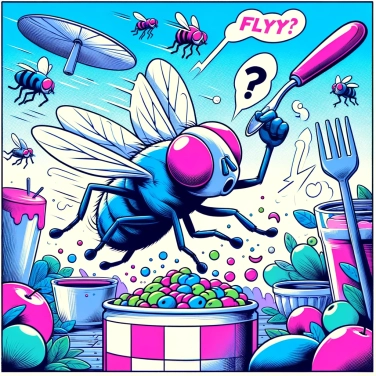Flies have very sensitive olfactory receptors that allow them to detect odor molecules emitted by food, even at very low concentrations. This allows them to quickly locate food sources.

Flies have an incredibly keen sense of smell, capable of detecting odors present in very small quantities. Their antennas are equipped with tiny sensory hairs covered in ultra-sensitive olfactory receptors. These receptors pick up the odor molecules released by decaying food, even from a distance. As soon as these volatile compounds come into contact with the antennas, the fly instantly identifies a potential food source with remarkable precision. This system allows them to locate tiny crumbs or freshly deposited food in just a few seconds.
Flies have compound eyes, made up of hundreds of small facets called ommatidia. These very special eyes provide flies with panoramic vision, allowing them to immediately spot a movement or a contrast. They see quite blurry, but they perceive rapid changes extremely well, such as a piece of sugar suddenly placed on a table or a crumb that has fallen from a baguette. Flies particularly detect bright and vibrant colors, associated with ripe fruits or sweet foods, thus enhancing their ability to quickly target potential sources of food.
Flies easily detect smells thanks to the antennae located on their heads, which serve as a true odor radar. These antennae have hypersensitive chemical receptors capable of recognizing the faintest trace of odor molecules lingering in the air. As soon as a food item emits volatile chemical compounds, such as those released by rotting food or a ripe fruit, the fly detects this invisible scent from a distance. It quickly analyzes the signal, pinpointing precisely where the smell is coming from, even at low concentrations. These odor cues allow it to perfectly identify what is edible and what does not interest it at all.
Flies have tiny, hyper-sensitive sensors on their antennae called olfactory receptors. These receptors finely detect minute variations in certain gases released by decaying food, such as carbon dioxide or ammonia. As soon as these gases fluctuate even slightly, the fly picks up the chemical message indicating "all-you-can-eat buffet this way," and quickly orients itself based on these gaseous cues. Essentially, it "sniffs" changes in the air from a distance and immediately understands which spot is worth checking out. It's like its personal radar, super handy for easily finding food without wasting time.
Flies use a dual-entry strategy by combining their highly developed sense of smell and their precise vision. The scent of decaying food guides them even from afar, then refined visual cues take over as the insect approaches the potential meal. They can distinguish colors, contrasts, or small shapes that indicate the certain presence of food. This sensory combination allows them to quickly target the snack with astonishing efficiency.
Flies have sensory receptors on their legs, allowing them to instantly taste a surface as soon as they come into contact with it.
Some species of flies can detect volatile chemical compounds from several kilometers away, allowing them to effectively locate food or decaying matter.
Flies use an extremely fast and agile flying mode, beating their wings up to 200 times per second. This sustained rhythm allows them to easily evade attempts at capture by humans.
The housefly has very sensitive hairs called sensilla, which can detect even the slightest variations in atmospheric pressure, helping to anticipate the presence of obstacles or predators.
In general, flies are particularly attracted to decomposing, sweet, or fermented foods, as these release highly odorous volatile chemical compounds. Ripe and decomposing fruits, sweet substances, and protein-rich organic residues are typical examples of foods that are very attractive to flies.
Flies frequently fly in circles to visually and chemically analyze their immediate environment. This allows them to precisely locate food, avoid potential predators or obstacles, and check the safety of the surface they are about to land on.
Sure! Here’s the translation: "Yes. Flies are attracted to light waves, especially ultraviolet (UV) radiation. This phenomenon explains why they are often found near artificial light sources. However, this attraction to light can sometimes temporarily divert them from seeking real food."
To limit the attraction of flies to food in a living space, it is essential to store food in airtight containers, clean dirty surfaces promptly, and regularly dispose of food waste. The use of screens and sticky traps can also prove effective.
Yes, flies have a highly developed olfactory sensitivity that allows them to detect food odors from several dozen meters away. They use antennae equipped with specialized receptors capable of identifying specific chemical molecules released by food.

0% of respondents passed this quiz completely!
Question 1/5